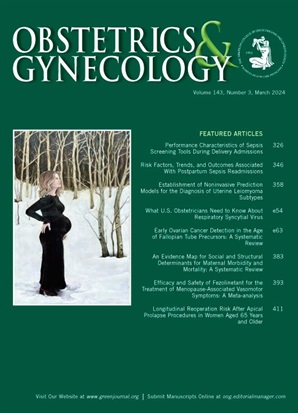盆底疾病手术患者的医疗保健差异:系统综述。
IF 4.7
2区 医学
Q1 OBSTETRICS & GYNECOLOGY
引用次数: 0
摘要
目的:探讨在美国盆底疾病接受手术治疗的患者中,与医疗保健差异相关的患者特征如何与获得护理和临床结果相关。数据来源我们检索了MEDLINE, EMBASE和ClinicalTrials.gov,截止到2024年3月25日。研究方法:与医疗保健差异相关的患者特征包括种族、民族、地理位置和保险状况等。结果包括获得手术、手术结果和患者报告的结果。符合条件的研究报告了多变量回归分析,包括至少一个与医疗保健差异相关的患者特征和一个纳入的研究结果。对于每个结果,我们描述了一致性(方向)、关联强度和与医疗保健差异相关的患者特征的研究数量。由于研究存在异质性,未进行meta分析。本综述由妇科外科学会系统综述组进行。表列、整合和结果在筛选的6853篇摘要中,纳入了42项研究,共84项多变量分析。脱垂手术中根尖悬吊术减少的相关特征包括来自农村地区或西班牙裔,黑人种族身份与网状物隆胸术减少有关。黑人种族身份和西班牙裔种族也与脱垂修复术比闭塞手术和脱垂修复术中出血的减少有关;年龄较大和拥有医疗保险与整体并发症的风险增加有关。非东北地区与脱垂手术后并发症的风险增加有关。少数民族患者在压力性尿失禁(SUI)手术后接受再手术的可能性较小。黑人与SUI手术后并发症无关。结论:美国少数民族患者、有医疗保险的患者和非东北地区的患者在盆底疾病手术治疗方面更有可能存在医疗保健差异。系统评审注册号:prospero, crd42021234511。本文章由计算机程序翻译,如有差异,请以英文原文为准。
Health Care Disparities in Patients Undergoing Surgery for Pelvic Floor Disorders: A Systematic Review.
OBJECTIVE
To explore how patient characteristics related to health care disparities are associated with access to care and clinical outcomes among patients receiving surgical treatment for pelvic floor disorders in the United States.
DATA SOURCES
We searched MEDLINE, EMBASE, and ClinicalTrials.gov through March 25, 2024.
METHODS OF STUDY SELECTION
Patient characteristics related to health care disparities included race, ethnicity, geographic location, and insurance status, among others. Outcomes included access to surgery, surgical outcomes, and patient-reported outcomes. Eligible studies reported multivariable regression analyses that included at least one patient characteristic related to health care disparities and an included study outcome. For each outcome, we describe the consistency (in direction), strength of association, and number of studies of the patient characteristic related to health care disparities. Meta-analysis was not performed because of study heterogeneity. This review was conducted by the Systematic Review Group of the Society of Gynecologic Surgeons.
TABULATION, INTEGRATION, AND RESULTS
Of 6,853 abstracts screened, 42 studies with a total of 84 multivariable analyses were included. Characteristics associated with decreased access to apical suspension during prolapse surgery included being from a rural area or of Hispanic ethnicity, and Black racial identity was associated with decreased access to mesh augmentation. Black racial identity and Hispanic ethnicity were also associated with decreased access to reconstructive prolapse repair compared with obliterative procedures and hemorrhage during prolapse repair; older age and having Medicare insurance were associated with increased risk of overall complications. Not being from the Northeast was associated with increased risk of overall complications after prolapse surgery. Patients from a minority race were less likely to undergo reoperation after stress urinary incontinence (SUI) surgery. Black race was not associated with complications after SUI surgery.
CONCLUSION
Patients in minoritized groups in the United States, those with Medicare insurance, and those not from the Northeast were more likely to have health care disparities related to surgical treatment for pelvic floor disorders.
SYSTEMATIC REVIEW REGISTRATION
PROSPERO, CRD42021234511.
求助全文
通过发布文献求助,成功后即可免费获取论文全文。
去求助
来源期刊

Obstetrics and gynecology
医学-妇产科学
CiteScore
11.10
自引率
4.20%
发文量
867
审稿时长
1 months
期刊介绍:
"Obstetrics & Gynecology," affectionately known as "The Green Journal," is the official publication of the American College of Obstetricians and Gynecologists (ACOG). Since its inception in 1953, the journal has been dedicated to advancing the clinical practice of obstetrics and gynecology, as well as related fields. The journal's mission is to promote excellence in these areas by publishing a diverse range of articles that cover translational and clinical topics.
"Obstetrics & Gynecology" provides a platform for the dissemination of evidence-based research, clinical guidelines, and expert opinions that are essential for the continuous improvement of women's health care. The journal's content is designed to inform and educate obstetricians, gynecologists, and other healthcare professionals, ensuring that they stay abreast of the latest developments and best practices in their field.
 求助内容:
求助内容: 应助结果提醒方式:
应助结果提醒方式:


